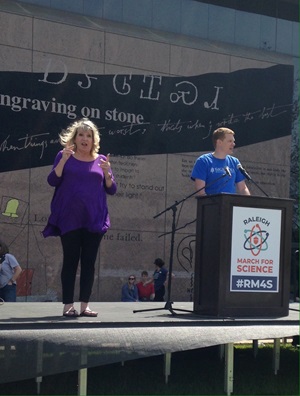April 18, 2018
The following prepared remarks were delivered by Sigma Xi Executive Director and CEO Jamie L. Vernon on April 14, 2018, at the March for Science in Raleigh, North Carolina. (You can watch a recording of the speech, starting at 42:00.)

Hello, North Carolina! I’m here to talk to you about the importance of STEM education.
What is STEM? Science, technology, engineering, and mathematics. These are the subjects we’re celebrating today.
Do we have any teachers in the audience? Do we have any STEM teachers in the audience? Ladies and gentlemen, these people are heroes and they deserve every bit of respect we can give them. Our teachers are crucial to our ability to solve the biggest challenges of our time: chronic diseases such as HIV and cancer, food shortages, access to clean water, climate change! Our teachers will educate and inspire the scientists and engineers who will solve these problems.
As a young boy, I asked a lot of questions. You might say I asked too many questions. Some of you parents of curious five- and six-year-olds may know exactly what I’m talking about. When it came to questions about science, I had a hard time getting satisfactory answers. Where did dinosaurs come from? How big is the Sun? What makes rain?
You see, I grew up in a small town called Sharpsburg, North Carolina. Population 800 or so, at the time. I didn’t know any scientists. In fact, I didn’t know anyone who had even gone to college, so the answers I received often didn’t seem quite right.
Then I met Ms. Saleeby. Ms. Saleeby introduced me to science. When I say science, I don’t mean that she just gave me facts. “The Sun has a radius of 432,169 miles.” No, she taught me the scientific method. She taught me that for every observation I made, for every question I had, I should develop a hypothesis to try to explain it on my own, given what I already knew about the subject. Then she taught me how to test my hypothesis.
My mind was blown and at an early age I understood that science was not just a series of facts. Science was a way of thinking. As I continued through school, I encountered more STEM teachers who nurtured this way of understanding the world. Mrs. Turner, Mrs. Page, Mr. Gall, Mrs. Cox, Mr. Creasy, and so many more. Each of these teachers contributed to my development as a young scientist and ultimately led me to pursue a PhD in cell and molecular biology.
 Today I am the CEO of Sigma Xi, the largest multidisciplinary honor society for scientists and engineers in the world. But my story is not unique. Teachers have contributed to the solution of every major crisis we’ve faced in the modern age.
Today I am the CEO of Sigma Xi, the largest multidisciplinary honor society for scientists and engineers in the world. But my story is not unique. Teachers have contributed to the solution of every major crisis we’ve faced in the modern age.
When the allies were confronted with possible defeat by the Axis Alliance in World War II, scientists were called upon to save us from tyranny. Many years prior, Augustus Klock who taught physics and chemistry at New York’s Ethical Culture School inspired a special young student to pursue a career in science. That student was none other than Robert Oppenheimer the father of the atomic bomb, which ended the war.
And thanks to the work of two prominent Sigma Xi members, Linus Pauling and Albert Einstein, the U.S. has not used a nuclear weapon of that magnitude since that time.
In 1957, when the Soviet Union launched the first artificial satellite into orbit around Earth, America feared that we were losing our global technological dominance. This motivated President John F. Kennedy to proclaim that the United States would land a man on the moon. Three minutes before the Apollo 11 lunar lander Eagle carrying Neil Armstrong and Buzz Aldrin reached the surface of the moon, computer alarms went off. The landing would have been aborted had it not been for former high school teacher and computer programmer Margaret Hamilton, who had anticipated the problem and created the software to solve it. Putting men on the moon restored America’s confidence in science and began a period of technological dominance that has extended until now.
 Today, we are facing numerous threats the likes of which humankind has never seen—from antibiotic resistant pathogens to climate change. Our dependence on fossil fuel has created an environmental crisis and once again science will be called upon to find a solution.
Today, we are facing numerous threats the likes of which humankind has never seen—from antibiotic resistant pathogens to climate change. Our dependence on fossil fuel has created an environmental crisis and once again science will be called upon to find a solution.
North Carolina, I say to you that the individuals who will develop the clean energy source that will help us break our addiction to fossil fuels could be in one of our classrooms, could be here today.
That’s why we have an obligation to invest in STEM education. We’re going to need the brain power of the next generation to fix the mistakes of the past. And we must ensure that students from all backgrounds are given the chance to contribute. Diversity in science leads to diversity in solutions.
And when these solutions emerge, we need to tell our elected leaders to do what their predecessors did. Believe in science. Use science. And continue to invest in science.
The beauty of investing in science is that it guarantees economic success. For decades, the United States has enjoyed tremendous wealth thanks to our previous technological achievements. We want the same for the next generation of Americans.
So do not let the messages you’ve heard here today fade away. Contact your representatives and tell them to stand up for science. And if they do not listen, come November, vote for science!
Photo captions:
Top photo: Sigma Xi Executive Director and CEO Jamie Vernon, on right, speaks to March for Science participants in Raleigh, North Carolina, about the importance of education about science, technology, engineering, and math.
Middle photo: The March for Science in Raleigh, North Carolina, was held in conjunction with marches across the world on April 14, 2018.
Bottom photo: Children colored signs at the Sigma Xi table at the March for Science in Raleigh.